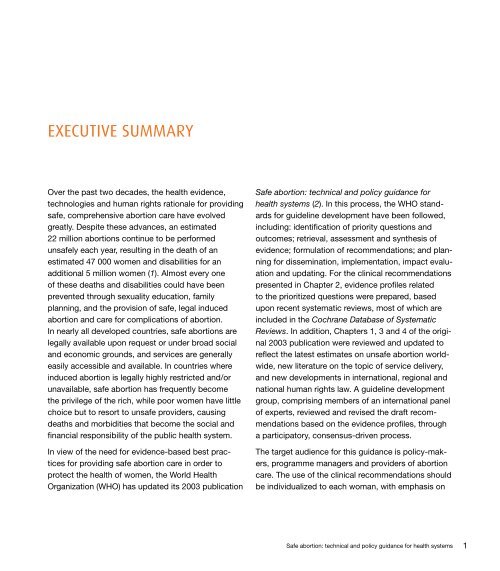Safe abortion:
Safe abortion:
Safe abortion:
You also want an ePaper? Increase the reach of your titles
YUMPU automatically turns print PDFs into web optimized ePapers that Google loves.
ExEcutivE summary<br />
Over the past two decades, the health evidence,<br />
technologies and human rights rationale for providing<br />
safe, comprehensive <strong>abortion</strong> care have evolved<br />
greatly. Despite these advances, an estimated<br />
22 million <strong>abortion</strong>s continue to be performed<br />
unsafely each year, resulting in the death of an<br />
estimated 47 000 women and disabilities for an<br />
additional 5 million women (1). Almost every one<br />
of these deaths and disabilities could have been<br />
prevented through sexuality education, family<br />
planning, and the provision of safe, legal induced<br />
<strong>abortion</strong> and care for complications of <strong>abortion</strong>.<br />
In nearly all developed countries, safe <strong>abortion</strong>s are<br />
legally available upon request or under broad social<br />
and economic grounds, and services are generally<br />
easily accessible and available. In countries where<br />
induced <strong>abortion</strong> is legally highly restricted and/or<br />
unavailable, safe <strong>abortion</strong> has frequently become<br />
the privilege of the rich, while poor women have little<br />
choice but to resort to unsafe providers, causing<br />
deaths and morbidities that become the social and<br />
financial responsibility of the public health system.<br />
In view of the need for evidence-based best practices<br />
for providing safe <strong>abortion</strong> care in order to<br />
protect the health of women, the World Health<br />
Organization (WHO) has updated its 2003 publication<br />
<strong>Safe</strong> <strong>abortion</strong>: technical and policy guidance for<br />
health systems (2). In this process, the WHO standards<br />
for guideline development have been followed,<br />
including: identification of priority questions and<br />
outcomes; retrieval, assessment and synthesis of<br />
evidence; formulation of recommendations; and planning<br />
for dissemination, implementation, impact evaluation<br />
and updating. For the clinical recommendations<br />
presented in Chapter 2, evidence profiles related<br />
to the prioritized questions were prepared, based<br />
upon recent systematic reviews, most of which are<br />
included in the Cochrane Database of Systematic<br />
Reviews. In addition, Chapters 1, 3 and 4 of the original<br />
2003 publication were reviewed and updated to<br />
reflect the latest estimates on unsafe <strong>abortion</strong> worldwide,<br />
new literature on the topic of service delivery,<br />
and new developments in international, regional and<br />
national human rights law. A guideline development<br />
group, comprising members of an international panel<br />
of experts, reviewed and revised the draft recommendations<br />
based on the evidence profiles, through<br />
a participatory, consensus-driven process.<br />
The target audience for this guidance is policy-makers,<br />
programme managers and providers of <strong>abortion</strong><br />
care. The use of the clinical recommendations should<br />
be individualized to each woman, with emphasis on<br />
<strong>Safe</strong> <strong>abortion</strong>: technical and policy guidance for health systems 1


